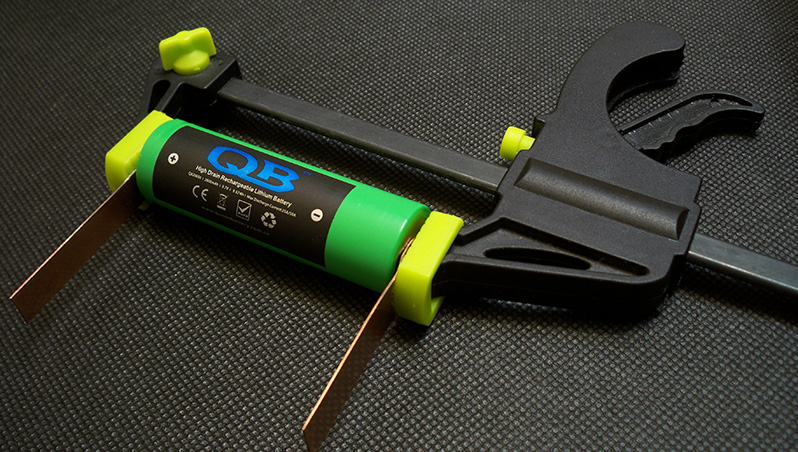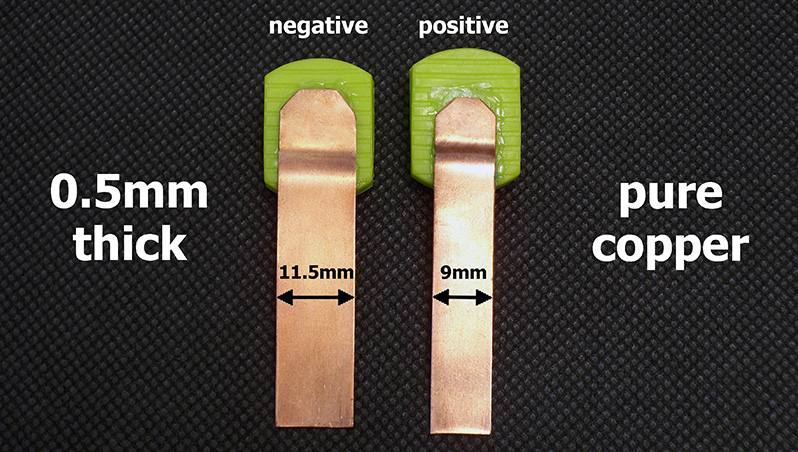thunderheart
Member
- Joined
- Apr 4, 2018
- Messages
- 276
10440 size is more known as AAA - it means that the cell is 10mm in diameter and 44mm long. In Lithium world 10440 is a rare size but you can find 3.2V LiFePO4 and 3.7V Li-ion models just by googling "10440". To feel the difference let's take a look at 10440 (AAA) next to 14500 (AA) and 18650:


This review's hero,Queen Battery QB10440, is a flat-top unprotected 300mAh-rated cell which also can be ordered with add-on protection PCB and button-top cap.

The battery was bought from my reliable supplier (Queen Battery) and tested withZKETECH EBC-A20and a self-made battery holder. It's a PC-connected battery tester supporting 4-wire measuring and discharging at up to 20A.

I've used version 3.0 of my battery holder based on 0.5mm thick pure copper terminals


I've followed all the prescriptions of theIEC61960-2003standard concerning battery's capacity measurement. Before each discharging cycle each battery was charged at standard charge current mentioned in its datasheet to charge end voltage. Before each discharging or charging i've held a 1-1.5hrs pause. The environment temperature was 23.0-24.5C. To be sure in results i've done each testminimum twice(usually 3-4 times).
Queen Battery QB10440 300mAh
The cell's heat shrink tube shows brief specifications but has absolutely no data about production date or batch number.

The main specifications from Queen Battery QB10440's datasheet:
Nominal capacity:320mAh
Minimum capacity:313mAh
Nominal voltage:3.7V
Standard charge current:150mA (0.5C)
Max charge current:300mA (1C)
Charge end voltage:4.20V
Max continuous discharge current:600mA (2C)
Discharge cut-off voltage:2.75V
AC impedance at 1KHz:?70m?
Weight:9g
Measured DC IR at 300mA in fully charged condition was 6310m? (using EB Tester Software's Resistance test)
Measured weight of the tested cell was 8.6g and the actual dimensions - 10.242.9mm

Queen Battery QB10440 300mAh capacity test results:

In case of QB10440 0.2C (for checking nominal capacity) is equal to 60mA and 0.02C (charge cut-off current) - 6mA. In both cases my battery tester allows 100mA as the minimum value which could be set, so instead of 6mA i cut the charge at 100mA and instead of 60mA test i did 100mA one. Even in those conditions QB10440's capacity was about 350mAh at 100mA discharge!!! I suggest that once it's charged using 6mA cut-off and discharged at 60mA it's capacity will be around 400mAh. At 300 and 600mA the curves look good. This guy handles 2C rate easily but i'd not recommend to go much higher than 600mA. This cell is not meant to power amp-hungry devices.
So, quick pros and cons:
+ more than 350mAh real capacity
+ up to 2C discharge rate
- 2.75V discharge cut-off current (harder to find a suitable protection PCB. Solution is to buy protected cells).
Here is the video version of this review:

Check outmyYouTube channelfor batteries, chargers and other stuff reviews.
I've launchedmy blogwhere you can find all my reviews in one place. Every new test/review will be first published on YouTube and in the blog. I'll be happy to see new subscribers, comments, suggestions and just your thoughts.


This review's hero,Queen Battery QB10440, is a flat-top unprotected 300mAh-rated cell which also can be ordered with add-on protection PCB and button-top cap.

The battery was bought from my reliable supplier (Queen Battery) and tested withZKETECH EBC-A20and a self-made battery holder. It's a PC-connected battery tester supporting 4-wire measuring and discharging at up to 20A.

I've used version 3.0 of my battery holder based on 0.5mm thick pure copper terminals


I've followed all the prescriptions of theIEC61960-2003standard concerning battery's capacity measurement. Before each discharging cycle each battery was charged at standard charge current mentioned in its datasheet to charge end voltage. Before each discharging or charging i've held a 1-1.5hrs pause. The environment temperature was 23.0-24.5C. To be sure in results i've done each testminimum twice(usually 3-4 times).
Queen Battery QB10440 300mAh
The cell's heat shrink tube shows brief specifications but has absolutely no data about production date or batch number.

The main specifications from Queen Battery QB10440's datasheet:
Nominal capacity:320mAh
Minimum capacity:313mAh
Nominal voltage:3.7V
Standard charge current:150mA (0.5C)
Max charge current:300mA (1C)
Charge end voltage:4.20V
Max continuous discharge current:600mA (2C)
Discharge cut-off voltage:2.75V
AC impedance at 1KHz:?70m?
Weight:9g
Measured DC IR at 300mA in fully charged condition was 6310m? (using EB Tester Software's Resistance test)
Measured weight of the tested cell was 8.6g and the actual dimensions - 10.242.9mm

Queen Battery QB10440 300mAh capacity test results:

In case of QB10440 0.2C (for checking nominal capacity) is equal to 60mA and 0.02C (charge cut-off current) - 6mA. In both cases my battery tester allows 100mA as the minimum value which could be set, so instead of 6mA i cut the charge at 100mA and instead of 60mA test i did 100mA one. Even in those conditions QB10440's capacity was about 350mAh at 100mA discharge!!! I suggest that once it's charged using 6mA cut-off and discharged at 60mA it's capacity will be around 400mAh. At 300 and 600mA the curves look good. This guy handles 2C rate easily but i'd not recommend to go much higher than 600mA. This cell is not meant to power amp-hungry devices.
So, quick pros and cons:
+ more than 350mAh real capacity
+ up to 2C discharge rate
- 2.75V discharge cut-off current (harder to find a suitable protection PCB. Solution is to buy protected cells).
Here is the video version of this review:

Check outmyYouTube channelfor batteries, chargers and other stuff reviews.
I've launchedmy blogwhere you can find all my reviews in one place. Every new test/review will be first published on YouTube and in the blog. I'll be happy to see new subscribers, comments, suggestions and just your thoughts.



